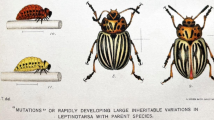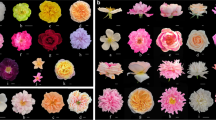Abstract
Developmental instability and fluctuating asymmetry (FA) describe the inability of organisms to correct for random accidents under development and has become a major but controversial topic in evolutionary biology. Theoretical models predict that the level of FA should increase as a result of inbreeding, but empirical results are ambiguous. Moreover, the relationship between fitness and FA is still debated. In the current study, plants from a population of Scabiosa canescens, a locally rare species in southern Sweden, were raised under uniform growth conditions to examine the effects of one-generation of selfing and outcrossing on FA in flower morphology. The level of flower FA was significantly higher (p = 0.038) for inbred progeny than for offspring derived from outcross pollinations. Given that earlier studies of this species have found no negative relation between heterozygosity and FA, the results support the conclusion that expression of deleterious recessive alleles are responsible for the increase of FA. There was no correlation between FA and estimates of five fitness-related traits when estimated at the individual level. However, a companion study found significant inbreeding depression for all fitness traits, and a negative association between FA and fitness could therefore be asserted at the treatment level (inbred/outbred progeny). Hence, FA seems to be useful to predict inbreeding depression in S. canescens, but specific individuals with high fitness cannot be identified based on their FA levels.
Similar content being viewed by others
References
Andalo, C., Bazin, A. and Shykoff, J.A. (2000) Is there a genetic basis for fluctuating asymmetry and does it predict fitness in the plant Lotus corniculatus grown in different environmental conditions? Int. J. Plant Sci. 161, 213-220.
Aronsson, M. (ed.) (1999) Rödlistade kärlväxter i Sverige-Artfakta (Swedish red data book of vascular plants). ArtDatabanken, SLU, Uppsala, Sweden.
Charlesworth, B. and Charlesworth, D. (1999) The genetic basis of inbreeding depression. Genet. Res. 74, 329-340.
Clarke, G.M. (1998) Developmental stability and fitness: the evidence is not quite so clear. Am. Nat. 152, 762-766.
Deng, H.-W. (1997) Increase in developmental instability upon inbreeding in Daphnia. Heredity 78, 182-189.
Dobzhansky, T.H. (1970) Genetics of the evolutionary process. Columbia University Press, New York.
Fenster, C.B. and Galloway, L.P. (1997) Developmental homeostasis and floral form: evolutionary consequences and genetic basis. Int. J. Plant Sci. 158(Suppl. 6), S121-S130.
Fowler, K. and Whitlock, M.C. (1994) Fluctuating asymmetry does not increase with moderate inbreeding in Drosophila melanogaster. Heredity 73, 373-376.
Gangestad, S.W. and Thornhill, R. (1999) Individual differences in developmental precision and fluctuating asymmetry: a model and its implications. J. Evol. Biol. 12, 402-416.
GENSTAT 5. 1998. Release 4.1. Lawes Agricultural Trust, Rothamsted Experimental Station, Rothamsted, UK.
Hochwender, C.G. and Fritz, R.S. (1999) Fluctuating asymmetry in a Salix hybrid system: the importance of genetic versus environmental causes. Evolution 53, 408-416.
Lerner, I.M. (1954) Genetic homeostasis. Wiley & Sons Inc., New York.
Lynch, M. and Walsh, B. (1998) Genetics and analysis of quantitative traits. Sinauer, Sunderland.
Markow, T.A. (1995) Evolutionary ecology and developmental instability. Ann. Rev. Entom. 40, 105-120.
Møller, A.P. (1997) Developmental stability and fitness: a review. Am. Nat. 149, 916-932.
Møller, A.P. and Swaddle, J.P. (1997) Asymmetry, developmental stability, and evolution. Oxford University Press, Oxford.
Møller, A.P. and Thornhill, R. (1997) A meta-analysis of the heritability of developmental stability. J. Evol. Biol. 10, 1-16.
Møller, A.P. and Shykoff, J.A. (1999) Morphological developmental stability in plants: patterns and causes. Int. J. Plant Sci. 160(Suppl. 6), S135-S146.
Palmer, A.R. and Strobeck, C. (1986) Fluctuating asymmetry: measurement, analysis, patterns. Ann. Rev. Ecol. Syst. 17, 391-421.
Paxman, G.J. (1956) Differentiation and stability in the development of Nicotiana rustica. Ann. Bot. 78, 331-347.
Perfectti, F. and Camacho, J.P.M. (1999) Analysis of genotypic differences in developmental stability in Annona cherimola. Evolution 53, 1396-1405.
Roy, B.A. and Stanton, M.L. (1999) Asymmetry of wild mustard, Sinapis arvensis (Brassicaceae), in response to severe physiological stresses. J. Evol. Biol. 12, 440-449.
Sherry, R.A. and Lord, E.M. (1996a) Developmental stability in flowers of Clarkia tembloriensis (Onagraceae). J. Evol. Biol. 9, 911-930.
Sherry, R.A. and Lord, E.M. (1996b) Developmental stability in leaves of Clarkia tembloriensis (Onagraceae) as related to population outcrossing rates and heterozygosity. Evolution 50, 80-91.
Siikamäki, P. (1999) Developmental instability in hybrids between Lychnis viscara and Lychnis alpina (Caryophyllaceae). Am. J. Bot. 86, 1683-1686.
Siikamäki, P. and Lammi, A. (1998) Fluctuating asymmetry in central and marginal populations of Lychnis viscaria in relation to genetic and environmental factors. Evolution 52, 1285-1292.
Thompson, R. and Welham, S.J. (1993) REML estimation of variance components and analysis of unbalanced designs. In GENSTAT 5 committee (eds) GENSTAT 5 Release 3 Reference Manual. Clarendon Press, Oxford, pp. 539-584.
Van Valen, L. (1962) A study of fluctuating asymmetry. Evolution 16, 125-142.
Vøllestad, L.A., Hindar, K. and Møller, A.P. (1999) A meta-analysis of fluctuating asymmetry in relation to heterozygosity. Heredity 83, 206-218.
Waldmann, P. (1999) The effect of inbreeding and population hybridization on developmental instability in petals and leaves of the rare plant Silene diclinis (Caryophyllaceae). Heredity 83, 138-144.
Waldmann, P. (2001) Additive and non-additive genetic architecture of two different-sized populations of Scabiosa canescens. Heredity 86, 648-657.
Waldmann, P. and Andersson, S. (1998) Comparison of quantitative genetic variation and allozyme diversity within and between populations of Scabiosa columbaria and S. canescens. Heredity 81, 79-86.
Wang, J., Hill, W.G., Charlesworth, D. and Charlesworth, B. (1999) Dynamics of inbreeding depression due to deleterious mutations in small populations: mutation parameters and inbreeding rate. Genet. Res. 74, 165-178.
Welham, S.J. and Thompson, R. (1997) Likelihood ratio tests for fixed model terms using residual maximum likelihood. J. R. Stat. Soc. B 59, 701-714.
Whitlock, M.C. and Fowler, K. (1999) The changes in genetic and environmental variance with inbreeding in Drosophila melanogaster. Genetics 152, 345-353.
Wilsey, B.J., Haukioja, E., Koricheva, J. and Sulkinoja, M. (1998) Leaf fluctuating asymmetry increases with hybridization and elevation in tree-line birches. Ecology 79, 2092-2099.
Author information
Authors and Affiliations
Rights and permissions
About this article
Cite this article
Waldmann, P. The effect of inbreeding on fluctuating asymmetry in Scabiosa canescens (Dipsacaceae). Evolutionary Ecology 15, 117–127 (2001). https://doi.org/10.1023/A:1013866608313
Issue Date:
DOI: https://doi.org/10.1023/A:1013866608313




